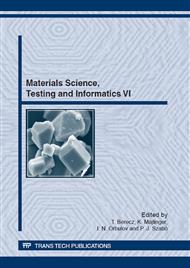[1]
I.N. Orbulov, J. Dobránszky, Producing metal matrix syntactic foams by pressure infiltration, Per. Pol. Mech. Eng. 52 (2008: 1) 35-42.
DOI: 10.3311/pp.me.2008-1.06
Google Scholar
[2]
P.K. Rohatgi, J.K. Kim, N. Gupta, S. Alaraj, A. Daoud, Compressive characteristics of A356/fly ash cenosphere composites synthesized by pressure infiltration technique, Comp. Part A 37 (2006) 430-437.
DOI: 10.1016/j.compositesa.2005.05.047
Google Scholar
[3]
P. K. Rohatgi, R.Q. Guo, H. Iksan, E.J. Borchelt, R. Asthana, Pressure infiltration technique for synthesis of aluminium-fly ash particulate composite, Mater. Sci. and Eng. A 244 (1998) 22-30.
DOI: 10.1016/s0921-5093(97)00822-8
Google Scholar
[4]
R.A. Palmer, K. Gao, T.M. Doan, L. Green, G. Cavallaro, Pressure infiltrated syntactic foams – Process development and mechanical properties, Mater. Sci. and Eng. A 464 (2007) 85-92.
DOI: 10.1016/j.msea.2007.01.116
Google Scholar
[5]
D.K. Balch, D.C. Dunand, Load partitioning in aluminum syntactic foams containing ceramic microspheres, Acta Mater. 54 (2006), 1501-1511.
DOI: 10.1016/j.actamat.2005.11.017
Google Scholar
[6]
D.K. Balch, J.G. O'Dwyer, G.R. Davis, C.M. Cady, G.T. Gray III, D.C. Dunand, Plasticity and damage in aluminium syntactic foams deformed under dynamic and quasi-static conditions, Mater. Sci. and Eng. A 391 (2005) 408-417.
DOI: 10.1016/j.msea.2004.09.012
Google Scholar
[7]
T. Bárczy, Gy. Kaptay, Modeling the infiltration of liquid metals into porous ceramics, Mater. Sci. Forum 473-474 (2005) 297-302.
DOI: 10.4028/www.scientific.net/msf.473-474.297
Google Scholar
[8]
P.K. Trumble, Spontaneous infiltration of non-cylindrical porosity: close-packed spheres, Acta Mater. 46 (1998) 2363-2367.
DOI: 10.1016/s1359-6454(98)80017-7
Google Scholar
[9]
M. Kiser, M.Y. He, F.W. Zok, The mechanical response of ceramic microballoon reinforced aluminum matrix composites under compressive loading, Acta Mater. 47 (1999: 9) 2685-2694.
DOI: 10.1016/s1359-6454(99)00129-9
Google Scholar
[10]
G.H. Wu, Z.Y. Dou, D.L. Sun, L.T. Jiang, B.S. Ding, B.F. He, Compression behaviours of cenosphere-pure aluminium syntactic foams, Scripta Mater. 56 (2007) 221-224.
DOI: 10.1016/j.scriptamat.2006.10.008
Google Scholar
[11]
Envirospheres Ltd. http: /www. envirospheres. com/products. asp, last accessed: 02. 01. (2012).
Google Scholar
[12]
H. M. Jaeger, S.R. Nagel, Physics of the granular state, Science 5051 (1992) 1523-1531.
Google Scholar
[13]
ASM Handbook Volume 4, Heat Treating, Third printing, ASM International (1995) 1861-(1960).
Google Scholar
[14]
Testing of metallic materials - Compression test of metallic cellular materials, DIN50134 standard, October (2008).
Google Scholar
[15]
E.W. Washburn, The dynamics of capillary flow, The Physical Review 17 (1921) 273-283.
Google Scholar
[16]
K.A. Semlak, F.N. Rhines, The rate of infiltration of metals, Trans. of The Metall. Soc. of AIME (1958) 325-331.
Google Scholar
[17]
R. Asthana, P.K. Rohatgi, N. Tewari, Infiltration processing of metal - matrix composites: a review, Process. of Adv. Mater. 2 (1992) 1-17.
Google Scholar
[18]
D. Muscat, R.A.L. Drew, Modelling the infiltration kinetics of molten aluminum into porous titanium carbide, Metall. and Mater. Trans. A 25 (1994) 2357-2370.
DOI: 10.1007/bf02648856
Google Scholar
[19]
C. Garcia-Cordovilla, E. Louis, J. Narciso, Pressure infiltration of packed ceramic particulates by liquid metals, Acta Mater. 47 (1999: 18) 4461-4479.
DOI: 10.1016/s1359-6454(99)00318-3
Google Scholar
[20]
G. Kaptay, Interfacial Aspects to produce particulate reinforced metal matrix composites, in Affordable Metal-Matrix Composites for High Performance Applications, Eds.: A. B. Pandey, K.L. Kending, T.J. Watson, TMS The Minerals, Metals & Materials Society (2001).
DOI: 10.1002/9781118787120.ch6
Google Scholar
[21]
I. N. Orbulov, J. Dobranszky, A. Nemeth, Microstructural characterisation of syntactic foams, J. of Mater. Sci. 44 (1009: 15) 4013-4019.
DOI: 10.1007/s10853-009-3552-2
Google Scholar


